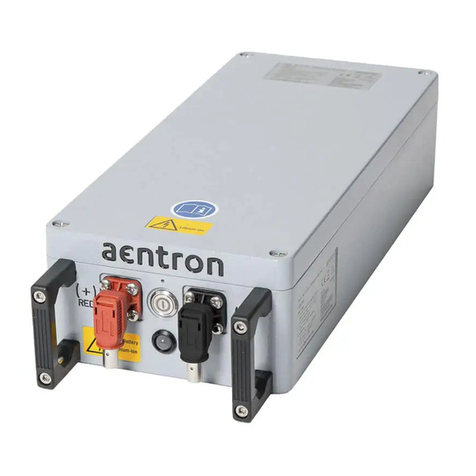Aentron A12020M User manual

Lithium-ion Battery
2 kWh - 12 V DC / 24 V DC / 48 V DC
Type M
Type R
A12
020M
A24020M
A48020M
A12020R
A24020R
A48020R
Version 1.3
Operating Manual
English
English

Table of Contents
Page 1/59 Lithium-ion Battery aentron GmbH
Version 1.03
Table of Contents
1. Introduction .............................................................................. 4
1.1. General ............................................................................................... 4
1.2. Terminology ....................................................................................... 5
1.3. Explanation of Symbols ................................................................... 5
1.3.1. Structure of the Safety Instructions ............................................. 5
1.3.2. Symbols, Warning Signs and Mandatory Signs .......................... 6
1.3.3. Abbreviations ..................................................................................... 7
1.4. Labelling ............................................................................................. 8
1.5. Contact Address ............................................................................... 9
2. About the aentron Lithium-ion Battery .............................. 10
2.1. Using the Lithium-ion Battery .................................................... 10
2.1.1. Intended Use .................................................................................. 10
2.1.2. Foreseeable Misuse ...................................................................... 11
2.2. Technical Data ............................................................................... 11
2.2.1. Dimensions ..................................................................................... 11
2.2.2. Electrical Specification ................................................................. 12
2.2.3. Additional Specifications ............................................................. 13
2.2.4. Ambient Conditions ....................................................................... 13
2.2.5. Standby Current Consumption ................................................... 14
2.3. Scope of Delivery ........................................................................... 15
2.3.1. Versions of the Lithium-ion Battery .......................................... 15
3. Safety ...................................................................................... 16
3.1. Basic Functional Safety................................................................ 16
3.2. Warnings of a General Nature .................................................... 17
3.3. Thermal Hazards............................................................................ 18
3.4. Electrical Hazards .......................................................................... 18
3.5. Dangers Caused by Materials and Substances ...................... 19
3.6. Safety Equipment .......................................................................... 19
4. Preparation for Use ............................................................... 20
4.1. Layout and Controls ...................................................................... 20
4.1.1. LED Definition ................................................................................ 21
4.2. Interfaces External Systems ........................................................ 22
4.3. Transport and Storage .................................................................. 24
4.3.1. Unpacking ....................................................................................... 25
4.4. Installation ...................................................................................... 25
4.4.1. Installation Location of the Lithium-ion Battery ..................... 25
4.4.2. Electrical Connection .................................................................... 26
4.4.3. Connections CAN Bus (only Type R) ......................................... 27

Table of Contents
aentron GmbH Lithium-ion Battery Page 2/59
Version 1.03
4.4.4. Checking the Functions ................................................................ 28
4.5. Commissioning ............................................................................... 28
5. Operation the Lithium-ion Battery ...................................... 29
5.1. General ............................................................................................ 29
5.2. Modes of Operation ...................................................................... 29
5.2.1. Parallel Connection ....................................................................... 30
5.3. Normal Operation .......................................................................... 31
5.3.1. Starting as a Stand-Alone Solution ........................................... 31
5.3.2. Charging .......................................................................................... 32
5.3.3. Charging Method ........................................................................... 33
5.3.4. Charge Equalisation ...................................................................... 33
5.3.5. Saving Power .................................................................................. 33
6. Maintenance ........................................................................... 34
6.1. Operational and maintenance standards for lithium-ion
batteries........................................................................................... 34
6.2. Avoidance of deep discharge ...................................................... 34
6.3. Operational life time ..................................................................... 35
6.4. Cycle life-time ................................................................................ 36
6.5. Service and repair .......................................................................... 36
6.5.1. Packaging ........................................................................................ 36
6.5.2. Dangerous good labels on the transport box ........................... 37
6.5.3. Transport service provider ........................................................... 38
7. Cleaning, Maintenance and Care ........................................ 39
7.1. Cleaning and Care ......................................................................... 39
7.2. Maintenance ................................................................................... 39
8. Decommissioning and Disposal .......................................... 40
8.1. Decommissioning .......................................................................... 40
8.2. Storage ............................................................................................. 41
8.3. Winter Storage ............................................................................... 42
8.4. Disposal and Recycling ................................................................ 42
9. Faults and Notifications ....................................................... 43
9.1. Troubleshooting ............................................................................. 43
9.2. Emergencies ................................................................................... 45
9.3. Frequently Asked Questions (FAQ) ........................................... 45
10. Legal Information .................................................................. 48
10.1. Warranty Conditions ..................................................................... 48
10.2. Copyright and Property Rights .................................................... 48
10.3. Material and Legal Defects ......................................................... 49
10.4. Approvals and EU Declaration of Conformity .......................... 49

Table of contents
Page 3/59 Lithium-ion Battery aentron GmbH
Version 1.02
10.5. EMC .................................................................................................. 51
11. Plans ........................................................................................ 52
11.1. Maintenance plan .......................................................................... 52
11.2. Maintenance Protocol .................................................................. 53

Introduction
General
aentron GmbH Lithium-ion Battery Page 4/59
Version 1.03
1. Introduction
1.1. General
This operating manual enables the safe and efficient handling of the
aentron lithium-ion battery and describes all the essential functions.
This operating manual ensures the safe operation of the lithium-ion battery
in accordance with the intended use.
This document contains:
■ Description of the design, functions and features of the lithium-ion
battery
■ Notes on possible dangers, their consequences and on measures for
hazard prevention
■ Detailed specifications on the standard operation of the lithium-ion
battery.
The operating manual must be stored away safely for users to be able to
access at any time. Please read the operating manual carefully before placing
the lithium-ion battery into operation.
For the safe and efficient use, all the safety instructions and handling
instructions of this operating manual must be read and understood.
Furthermore, we recommend following the requirements of
EN ISO 16315:2016 for the integration and professional installation of the
lithium-ion battery.
In this operating manual, the latest version of the lithium-ion battery is
described. If changes or supplements are required in the future, the operating
manual is amended, and all amendment are included in the next revision.
The respective version of the operating manual is displayed on the cover
sheet and in the footer; this operating manual is version "1.0". The version
will be increased by "1" with every revision.
aentron GmbH reserves the right to make changes to systems and
documentation without notifying users of previous versions.
TIP
If the lithium-ion battery is passed or sold on to third parties, the
following documents must be passed on to the new user:
This operating manual
Documentation of repair work carried out.
This manual suits for next models
5
Table of contents
Other Aentron Camera Accessories manuals
Popular Camera Accessories manuals by other brands

Trojan
Trojan GC2 48V quick start guide

Calumet
Calumet 7100 Series CK7114 operating instructions

Ropox
Ropox 4Single Series User manual and installation instructions

Cambo
Cambo Wide DS Digital Series Main operating instructions

Samsung
Samsung SHG-120 Specification sheet

Ryobi
Ryobi BPL-1820 Owner's operating manual












